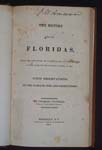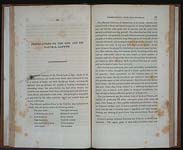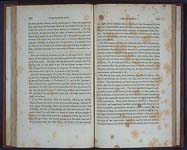Vignoles, Charles
The History of the Floridas, From the Discovery by Cabot, in 1497, to the Cession of the Same to the United States, in 1821. With Observations on the Climate, Soil and Productions. Brooklyn, N.Y. 1824. 219 pp. This volume includes an errata leaf and is bound in antique speckled calf, with spine gilt, and a leather label.




This is the second edition, expanded from the first of the previous year, and represents one of the first detailed accounts of Florida published in the United States after the acquisition of that territory from Spain. Vignoles, an Irish-born engineer, made several extensive trips to Florida. He describes the geography, climate, soil, Indian tribes and British and Spanish settlements and activities there. Also included is a printing of the Adams-Onis Treaty by which the Floridas were sold to the United States. Vignoles produced a map of Florida as well, but it was sold separately from the book and does not usually appear with it. The following is interjected on the page following his introduction:
The map of Florida which is published at the same time with this book, by the author, will for the accommodation of the public, be sold, either bound up with it, or separately in sheets, done up in cases or mounted and varnished, with roller, colored or uncolored as required.
Vignoles purpose with his book and map was to create a reliable guide for persons travelling by water and land around East Florida, and he included as much information as he could obtain from other sources about areas with which he was not as familiar. Vignoles writes in his introduction:
The newly acquired territory of Florida has advanced the soil of the Union to the very verge of the tropics, and by placing the ports from the mouths of the Mississippi round to Amelia island, under the American flag, has hermetically closed all approaches to our interior.... The following observations upon the Floridas have been collected, during a residence in the country; in which period several extensive journeys were made, with a view of obtaining materials for the construction of a new map, and for the purpose now brought forward.
Vignoles concludes at the end of the volume:
Florida is now a republic; unshackled by the restrictions of a monarch, or the despotic ways of an inquisitorial governor, ... it will soon develop the real extent of its capabilities.... With a superficial extent larger than the state of New-York, with a climate in most parts as salubrious as the rest of the United States, with a soil capable of producing more than one lucrative staple, it is surely no visionary hope that we indulge when we look forward beyond the few years that are to intervene before FLORIDA takes her natural post of importance in the FEDERAL UNION.
Charles Vignoles was born in Wexfod County in 1793. That same year he traveled to the West Indies with his parents, accompanying his father's regiment under the command of Sir Charles Grey. The family became prisoners of war of the French and all contracted yellow fever while in captivity. Only the infant Charles survived. Upon his return to England, Vignoles lived with his paternal grandfather and received financial support from a commission from Prince Edward. In 1817, Vignoles sailed to the United States and was hired as a civil engineer in South Carolina. He worked there for three years, helping to prepare an official map of the state. In 1821 he worked on a similar mapping project in St. Augustine, Florida. To further his interests as a land agent in Florida, Vignoles worked to prepare a new map of Florida, which he published in conjunction with a handbook for new settlers. After returning to Europe in May 1823, Vignoles was employed to take surveys on the Liverpool and Manchester Railways. He was successful in his new career and patented several railroad equipment improvements.